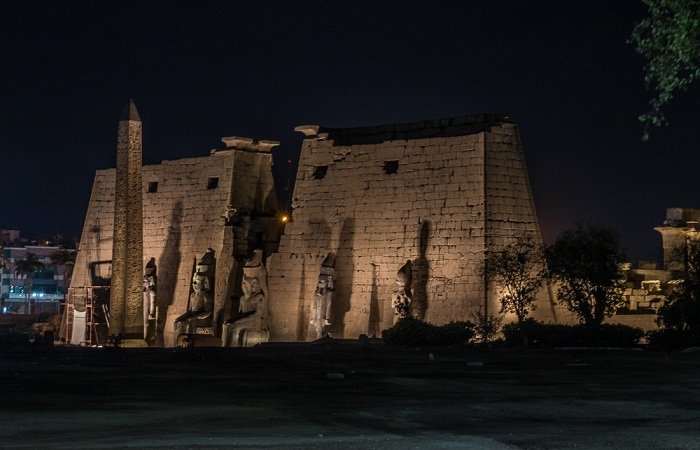Wonderful Luxor East Bank.
Homer described Luxor city in ancient times as the city of hundred gates referring to its greatness and its huge buildings. Luxor is considered as the world’s greatest open-air museum because it holds two-thirds of the landmarks of the world. Most of these unparalleled monuments date back to ancient Egyptian history.
Luxor city is divided into two parts:
The first part is the east bank dedicated to the living. It contains the Luxor temple, Karnak Temple, Mummification Museum, and Luxor Museum.
While the second one is the west bank was for burying the dead. It holds Valley of the Kings, Valley of the Queens, and the nobles’ tombs.
What is the ancient history of Luxor city?
The Thebes city was located in this place. This city was the capital of ancient Egypt many times whereas it was the capital during the first part of the middle kingdom (the 11th dynasty) and in the New Kingdom.
The golden age of this city was during the new kingdom because it was the seat of the rule for kings who ruled this huge empire extended from Libya to Khita. That began when Ahmose defeated Hyksos, expelled them from Egypt, and began the 18th dynasty.
What are the names of Thebes city?
This city had different names during the Egyptian history.
It was called in ancient times with (Waset) means Sceptre referring that it is the seat of rule. It is also known as Pr Amun meaning (the House of Amun) because it was the center for worshiping the god Amun.
When the Greeks came to Egypt, they called it Thebes.
When the Arabs entered Thebes city, they called its temples with Luxor that is an Arabic word meaning palaces.
In this article, Explore Egypt Tours presents the monuments located on the East Bank of the Nile River.
1 – Luxor Templ
What is the history of this temple?
Luxor temple was built by King Amenhotep III during the 18th dynasty, New kingdom. It was dedicated to the Triad of Thebes (Amun-Ra, his wife the goddess Mut, and their son Khonsu). Then during the 19th dynasty, King Ramses II added the front part.
During the Roman period, this temple changed to be a legionary fortress for the Roman government, and then it contained a church during the Christian period.
What is the construction of the Luxor temple?
There were several kings expanded the temple and added buildings such as Thutmose III and Ramesses II.
There is an avenue of sphinxes was built by king Nektanebo. The temple starts with the great pylon was built by Ramesses II, and one obelisk, while the second obelisk was transferred to La Place de le Concorde in Paris.
Then open court of Ramesses II where you will see the shrine of Hatshepsut and Thutmose III and Abu Haggag Mosque built on the temple walls, then the colonnade of Amenhotep III, then the court of Amenhotep III. Additionally, you will see the birth room of Amenhotep III and Alexander the Great shrine.
Luxor temple has a lot of inscriptions such as the Battle of Kadesh on the first pylon, and the annual Opet Festival which the god Amun transferred from Luxor Temple to Karnak Temple.

2 – The avenue of Sphinxes
The avenue of sphinxes runs 3 kilometers tall. This road is linking between the Luxor and Karnak Temples. It was used during the annual Opet Festival. The construction of the avenue of Sphinxes was begun during king Nectanebo in the 30th Dynasty.
This road is divided into two parts:
The first part has lined in front of the Luxor temple containing sphinxes statues (with a human head and lion body).
While the second part is in front of Karnak temple holding ram-headed avenue of Sphinxes.

3 – Karnak Temple
This temple is considered as the largest temple complex constructed in the world. Its religious significance is shown in its enormous size. It holds a group of temples added by the kings throughout ancient history.
What is the history of Karnak temple?
The construction of Karnak temple started in the middle kingdom, and throughout history, the kings added to the temple building until the 30th dynasty during king Nakhtinbo period. It was also dedicated to the triad of Thebes.
What can be seen in this temple?
When you visit the Karnak temple, you will be amazed by its many buildings such as the Great Temple of Amon Ra, The Temple of Khonso, the pillars of Taharqa that take the papyrus shape, the Ramses II Temple, and the vast sacred lake.
Karnak temple presents the sound and light show displayed the history of the Karnak temple at night.
When you visit this great complex, Explore Egypt Tours tour guide will tell you many stories about it. So kindly submit on our Luxor day tours. 

4 – Mummification Museum
This Museum explains the mummification process by displaying what happens inside the mummification tent, identical to the ones used in ancient times. Additionally, it displays the tools used in the process, and mummified animals such as baboons, cats, birds, and crocodiles.
This museum offers you a unique opportunity to experience to practice mummification by yourself.

5 – Luxor Museum
This museum is opened in 1975. It consists of 2 floors displaying well-carved statues. In 1989, the cache hall was added to the museum to display the statues discovered in the cache of Luxor Temple. These statues are for gods and kings.

Explore Egypt Tours Tripadvisor


Comment (0)